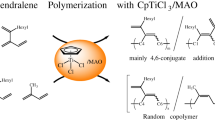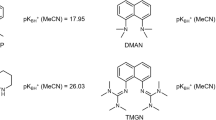Abstract
Coordination polymerization of the triphenylamine-substituted styrene derivatives N,N-diphenyl-4′-vinyl-[1,1′-biphenyl]-4-amine (FSt1) and N,N-bis(4-bromophenyl)-4′-vinyl-[1,1′-biphenyl]-4-amine (FSt2) was successfully achieved via the rare-earth metal catalyst (C5Me4SiMe3)Sc-(CH2SiMe3)2(THF). The catalyst system showed high activity and excellent syndioselectivity (rrrrå 99%) for the polymerization of FSt. Moreover, the syndioselective copolymerization of FSt with styrene was also achieved with this catalyst system. The insertion rate of triphenylamine-substituted monomers could be tuned by simply changing the feed amount. Strikingly, the copolymers showed random or gradient sequence distributions depending on the different reactivity ratios of FSt with St. Representative photophysical properties, such as those observed using UV–vis absorption and fluorescence spectroscopy, of the (co)polymers were also characterized.
This is a preview of subscription content, access via your institution
Access options
Subscribe to this journal
Receive 12 print issues and online access
$259.00 per year
only $21.58 per issue
Buy this article
- Purchase on Springer Link
- Instant access to full article PDF
Prices may be subject to local taxes which are calculated during checkout








Similar content being viewed by others
References
Ishihara N, Seimiya T, Kuramoto M, Uoi M. Crystalline syndiotactic polystyrene. Macromolecules. 1986;19:2464–5.
Zinck P, Bonnet F, Mortreux A, Visseaux M. Functionalization of syndiotactic polystyrene. Prog Polym Sci. 2009;34:369–92.
Jaymand M. Recent progress in the chemical modification of syndiotactic polystyrene. Poly Chem. 2014;5:2663–90.
Li HM, Chen HB, Shen ZG, Lin S. Preparation and characterization of maleic anhydride-functionalized syndiotactic polystyrene. Polymer. 2002;43:5455–61.
Abbasian M. Synthesis of functional syndiotactic polystyrene copolymers with graft and block structures by nitroxide-mediated living radical polymerization. J Elastomers Plast. 2011;43:481–497.
Noble KF, Noble AM, Talley SJ, Moore RB. Blocky bromination of syndiotactic polystyreneviapost-polymerization functionalization in the heterogeneous gel state. Polym Chem. 2018;9:5095–106.
Wang ZC, Wang MY, Liu JY, Liu DT, Cui DM. Rapid syndiospecific (Co)polymerization of fluorostyrene with high monomer conversion. Chem Eur J. 2017;23:18151–5.
Wang T, Liu DT, Cui DM. Highly syndioselective coordination (Co)polymerization ofortho-fluorostyrene. Macromolecules. 2019;52:9555–60.
Wu Y, Wang ZC, Liu DT, Liu B, Cui DM. Highly syndioselective coordination (Co)polymerization ofpara-chlorostyrene. Macromolecules. 2020;53:8333–9.
Guo F, Jiao N, Jiang L, Li Y, Hou ZM. Scandium-catalyzed syndiospecific polymerization of halide-substituted styrenes and their copolymerization with styrene. Macromolecules. 2017;50:8398–405.
Liu DT, Wang R, Wang MY, Wu CJ, Wang ZC, Yao CG et al. Syndioselective coordination polymerization of unmasked polar methoxystyrenes using a pyridenylmethylene fluorenyl yttrium precursor. Chem Commun. 2015;51:4685–8.
Wang R, Liu DT, Li XH, Zhang J, Cui DM, Wan XH. Synthesis and stereospecific polymerization of a novel bulky styrene derivative. Macromolecules. 2016;49:2502–10.
Liu DT, Wang MY, Wang ZC, Wu CJ, Pan YP, Cui DM. Stereoselective copolymerization of unprotected polar and nonpolar styrenes by an yttrium precursor: control of polar-group distribution and mechanism. Angew Chem Int Ed 2017;56:2714–9.
Liu DT, Wang MY, Chai YJ, Wan XH, Cui DM. Self-activated coordination polymerization of alkoxystyrenes by a yttrium precursor: stereocontrol and mechanism. ACS Catal. 2019;9:2618–25.
Xu ST, Wang JX, Zhai JJ, Wang F, Pan L, Shi XC. Imidazoline-2-imine Functionalized Fluorenyl Rare-Earth Metal Complexes: Synthesis and Their Application in the Polymerization ofortho-methoxystyrene. Organometallics. 2021;40:3323–30.
Shi ZH, Guo F, Li Y, Hou ZM. Synthesis of amino-containing syndiotactic polystyrene as efficient polymer support for palladium nanoparticles. J Polym Sci, Part A: Polym Chem. 2015;53:5–9.
Wang ZC, Liu DT, Cui DM. Statistically syndioselective coordination (Co)polymerization of 4-methylthiostyrene. Macromolecules. 2016;49:781–7.
Zhang Z, Dou YL, Cai ZY, Liu DT, Li SH, Cui DM. Syndioselective coordination (Co)polymerization of alkyne-substituted Styrenes using rare-earth metal catalysts. Macromolecules. 2020;53:5895–902.
Zhong YH, Wu Y, Cui DM. Highly Syndiotactic Coordination (Co)polymerization of para-Methylselenostyrene. Macromolecules. 2021;54:1754–9.
Yeh KM, Lee CC, Chen Y. Poly(4-vinyltriphenylamine): optical, electrochemical properties and its new application as a host material of green phosphorescent Ir(ppy)3 dopant. Synth Met. 2008;158:565–71.
Park JH, Yun C, Park MH, Do Y, Yoo S, Lee MH. Vinyl-type polynorbornenes with triarylamine side groups: a new class of soluble hole-transporting materials for OLEDs. Macromolecules. 2009;42:6840–3.
Fang YK, Liu CL, Yang GY, Chen PC, Chen WC. New donor−acceptor random copolymers with pendent triphenylamine and 1,3,4-oxadiazole for high-performance memory device applications. Macromolecules. 2011;44:2604–12.
Li YW, Xue LL, Xia HJ, Xu B, Wen SP, Tian WJ. Synthesis and properties of polythiophene derivatives containing triphenylamine moiety and their photovoltaic applications. J Polym Sci, Part A: Polym Chem. 2008;46:3970–84.
Lee SK, Ahn T, Cho NS, Lee JI, Jung YK, Lee J et al. Synthesis of new polyfluorene copolymers with a comonomer containing triphenylamine units and their applications in white-light-emitting diodes. J Polym Sci, Part A: Polym Chem. 2007;45:1199–209.
Mutaguchi D, Okumoto K, Ohsedo Y, Moriwaki K, Shirota Y. Development of a new class of hole-transporting and emitting vinyl polymers and their application in organic electroluminescent devices. Org Electron. 2003;4:49–59.
Park MH, Huh JO, Do Y, Lee MH. Synthesis and properties of polyethylene with side-chain triphenylamines as hole-transporting materials. J Polym Sci, Part A: Polym Chem. 2008;46:5816–25.
Tew GN, Pralle MU, Stupp SI. Supramolecular materials with electroactive chemical functions. Angew Chem Int Ed. 2000;39:517–21.
Natori I, Natori S, Usui H, Sato H. Anionic Polymerization of 4-Diphenylaminostyrene: Characteristics of the Alkyllithium/N,N,N′,N′-Tetramethylethylenediamine System for Living Anionic Polymerization. Macromolecules. 2008;41:3852–8.
Higashihara T, Ueda M. Living Anionic Polymerization of 4-Vinyltriphenylamine for Synthesis of Novel Block Copolymers Containing Low-Polydisperse Poly(4-vinyltriphenylamine) and Regioregular Poly(3-hexylthiophene) Segments. Macromolecules. 2010;43:8794–800.
Kang BG, Jang J, Song Y, Kim MJ, Lee T, Lee JS. Well-Defined Block Copolymers with Triphenylamine and Isocyanate Moieties Synthesized via Living Anionic Polymerization for Polymer-Based Resistive Memory Applications: Effect of Morphological Structures on Nonvolatile Memory Performances. Macromolecules. 2014;47:8625–33.
Kang BG, Jang J, Song Y, Kim MJ, Lee T, Lee JS. Facile anionic synthesis of a well-controlled thermally cross-linkable block copolymer for polymer-based resistive memory device applications. Polym Chem. 2015;6:4264–70.
Lindner SM, Thelakkat M. Nanostructures of n-type organic semiconductor in a p-type matrix via self-assembly of block copolymers. Macromolecules. 2004;37:8832–5.
Tsutsumi N, Murano T, Sakai W. Photorefractive response of polymeric composites with pendant triphenylamine moiety. Macromolecules. 2005;38:7521–7253.
Lindner SM, Thelakkat M. Fluorescent dye-labeled polymers carrying triphenylamine, styrene, or acrylate pendant groups. Macromol Chem Phys. 2006;207:2084–92.
Peter K, Thelakkat M. Synthesis and characterization of bifunctional polymers carrying tris(bipyridyl)ruthenium(II) and triphenylamine units. Macromolecules. 2003;36:1779–85.
Bacher E, Bayerl M, Rudati P, Reckefuss N, Müller CD, Meerholz K et al. Synthesis and characterization of photo-cross-linkable hole-conducting polymers. Macromolecules. 2005;38:1640–7.
Chuang CN, Chuang HJ, Wang YX, Chen SH, Huang JJ, Leung ML et al. Polymers with alkyl main chain pendent biphenyl carbazole or triphenylamine unit as host for polymer light emitting diodes. Polymer. 2012;53:4983–92.
Lei L, Ma HC, Qin YF, Yang MY, Ma YC, Wang T et al. AIE-active florescent polymers: the design, synthesis and the cell imaging application. Polymer. 2017;133:151–9.
Hreha RD, Haldi A, Domercq B, Barlow S, Kippelen B, Marder SR. Synthesis of acrylate and norbornene polymers with pendant 2,7-bis(diarylamino)fluorene hole-transport groups. Tetrahedron. 2004;60:7169–76.
Bellmann E, Shaheen SE, Thayumanavan S, Barlow S, Grubbs RH, Marder SR et al. New triarylamine-containing polymers as hole transport materials in organic light-emitting diodes: effect of polymer structure and cross-linking on device characteristics. Chem Mater. 1998;10:1668–76.
Kimyonok A, Domercq B, Haldi A, Cho JY, Carlise JR, Wang XY et al. Norbornene-based copolymers with iridium complexes and bis(carbazolyl)fluorene groups in their side-chains and their use in light-emitting diodes. Chem Mater 2007;19:5602–8.
Hirao A, Hayashi M, Loykulnant S, Sugiyama K, Ryu SW, Haraguchi N et al. Precise syntheses of chain-multi-functionalized polymers, star-branched polymers, star-linear block polymers, densely branched polymers, and dendritic branched polymers based on iterative approach using functionalized 1,1-diphenylethylene derivatives. Prog Polym Sci. 2005;30:111–82.
Hirao A, Tsunoda Y, Matsuo A, Sugiyama K, Watanabe T. Precise synthesis of dendron-like hyperbranched polymers and block copolymers by an iterative approach involving living anionic polymerization, coupling reaction, and transformation reaction. Macromol Res. 2006;14:272–86.
Higashihara T, Inoue K, Nagura M, Hirao A. Successive synthesis of well-defined star-branched polymers by an iterative approach based on living anionic polymerization. Macromol Res. 2006;14:287–99.
Hsu JC, Chen Y, Kakuchi T, Chen WC. Synthesis of Linear and Star-Shaped Poly[4-(diphenylamino)benzyl methacrylate]s by Group Transfer Polymerization and Their Electrical Memory Device Applications. Macromolecules. 2011;44:5168–77.
Sessions LB, Cohen BR, Grubbs RB. Alkyne-Functional Polymers through Sonogashira Coupling to Poly(4-bromostyrene. Macromolecules. 2007;40:1926–33.
Shin J, Chang Y, Nguyen T, Noh S, Bae C. Hydrophilic functionalization of syndiotactic polystyrene via a combination of electrophilic bromination and Suzuki-Miyaura reaction. J Polym Sci, Part A: Polym Chem. 2010;48:4335–43.
Dobruchowska E, Glowacki I, Ulanski J, Sanetra J, Pielichowski J. Thermoluminescence of poly(9-vinylcarbazole) modified by substitution with halogens. Chem Phys. 2008;348:249–53.
Slyusareva EA, Tomilina FN, Sizykh AG, Tankevich EY, Kuzubov AA, Ovchinnikova SG. The effect of halogen substitution on the structure and electronic spectra of fluorone dyes. Opt Spectrosc. 2012;112:671–8.
Gayathri P, Karthikeyan S, Pannipara M, Sehemi AGA, Moon D, Anthony SP. Aggregation-enhanced emissive mechanofluorochromic carbazole-halogen positional isomers: tunable fluorescenceviaconformational polymorphism and crystallization-induced fluorescence switching. CrystEngComm. 2019;21:6604–12.
Li XF, Nishiura M, Hu LH, Mori K, Hou ZM. Alternating and random copolymerization of isoprene and ethylene catalyzed by cationic half-sandwich scandium alkyls. J Am Chem Soc. 2009;131:13870–82.
Chien JCW, Tsai WM, Rausch MD. Isospecific polymerization of propylene catalyzed by rac-ethylenebis(indenyl)methylzirconium cation. J Am Chem Soc. 1991;113:8570–1.
Acknowledgements
This work was financially supported by the National Natural Science Foundation of China (No. 51803019) and the Fundamental Research Funds for the Central Universities (No. DUT20LAB138).
Author information
Authors and Affiliations
Corresponding authors
Ethics declarations
Conflict of interest
The authors declare no competing interests.
Additional information
Publisher’s note Springer Nature remains neutral with regard to jurisdictional claims in published maps and institutional affiliations.
Supplementary information
Rights and permissions
About this article
Cite this article
Mu, X., Yu, J., Leng, X. et al. Syndioselective coordination (Co)polymerization of triphenylamine-substituted styrenes via a scandium catalyst system. Polym J 54, 775–782 (2022). https://doi.org/10.1038/s41428-022-00628-w
Received:
Revised:
Accepted:
Published:
Issue Date:
DOI: https://doi.org/10.1038/s41428-022-00628-w



